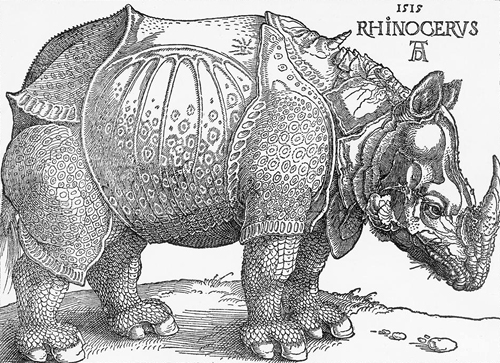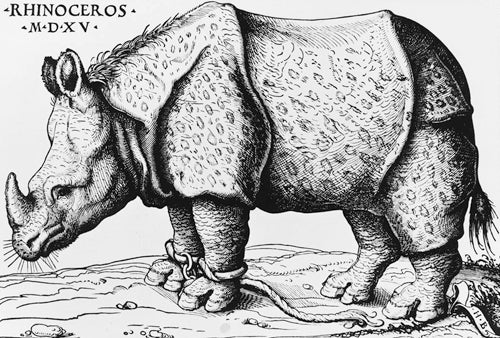
Albrecht Dürer created his famous woodcut of a rhinoceros in 1515 based on a written description and an anonymous sketch of an Indian rhino that had arrived in Lisbon earlier that year. The animal was intended as a gift for Pope Leo X from the king of Portugal, but it never reached its destination, perishing in a shipwreck off the coast of Italy.
Dürer’s image is less than accurate, depicting an animal covered with an armor of hard plates, scales on its feet, and a small spiral horn on its back. This is not exactly surprising, considering the artist never saw the actual specimen. What is surprising is that his depiction served as a scientific reference for centuries, despite the existence of a similar but more accurate print by Hans Burgkmair, also from 1515. The similarities between the two images suggest that Burgkmair may have also based his woodcut on the same anonymous sketch.

In a fascinating article in Print Quarterly, Jim Monson discusses yet a third rhinoceros image from 1515, this one by an unknown artist. The drawing, in the collection of the Vatican Library, has elements found in Dürer’s print but not on Burgkmair’s and vice-versa, which leads Monson to wonder whether it is closer to the lost image that inspired both Dürer and Burgkmair.
The Artstor Digital Library offers more than a dozen different images of Dürer’s rhinoceros prints (the example here comes from the Berlin State Museums). Search for Burgkmair rhinoceros to compare the two artists’ versions, or search for rhinoceros to find depictions as varied as a prehistoric terracotta figurine from India in the American Council for Southern Asian Art (ACSAA) Collection to 20th-century circus posters in the John and Mable Ringling Museum of Art Circus Collection.


